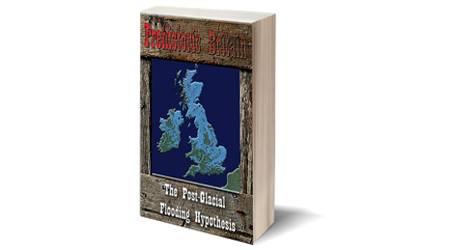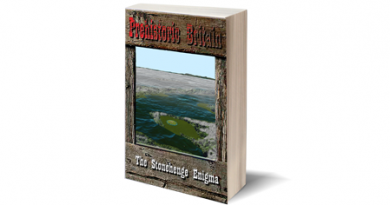Post Glacial Flooding – Flipbook
The Post Glacial Flooding Hypothesis – Robert John Langdon
In the context of “The Post-Glacial Flooding Hypothesis,” an investigation was undertaken into novel mathematical models designed to facilitate the quantification of water release events that transpired during and following the Last Glacial Maximum, approximately ten millennia ago. Should it be postulated that the Dykes of Britain functioned as water conduits instead of serving solely as demarcation or defensive structures, it necessitates the establishment of empirical evidence affirming that the historical water table was situated at higher elevations than the present state. Absent such evidence, these structures would perpetually remain inundated.
The computational models embedded within the Post-Glacial Flooding Hypothesis yielded an astounding outcome, revealing a minimum discharge of 8.42 quadrillion metric tonnes of water onto the expanse of the United Kingdom upon the conclusion of the last ice age. This voluminous magnitude is akin to the hypothetical scenario of 98,425.2 inches of precipitation evenly distributed over every square inch of the British landmass or the conceptualisation of an unbroken, incremental descent of one inch of rainfall each day for a continuous duration of 270 years.
Within the annals of British meteorological history, the most notable inundation is encapsulated in the deluge of 1947. This catastrophic event unfolded due to a trifling six inches of rainfall, equivalent to 149 millimetres, merging with the progressive thaw of a maximum of 12 inches of snow accumulation, culminating in an absolute liquid accumulation not exceeding 15 inches over three months. This inundation, characterized by its expansive geographical impact, affected nearly all major river systems in England’s South, Midlands, and Northeast regions, earning distinction for its origins, extensive reach, and prolonged duration.
Over a fortnight, this calamity extended its grasp to encompass thirty of the forty English counties, submerging approximately 700,000 acres of land. Consequently, tens of thousands of individuals experienced temporary displacement from their residences, and thousands of acres of crops faced irrevocable losses. It is noteworthy that this event, despite its monumental scale, represents only a fraction—precisely, a mere 15 inches—of the estimated equivalent of 98,425 inches of water that the British landscape bore witness to following the conclusion of the last Ice Age. The enduring ramifications of this ancient deluge persistently shape the contemporary geographical and hydrological landscape.
Raised Water Table
According to William Donn (Donn et al., 1962). The Fennoscandian and Great Britain ice sheet covered 4.7 106 km2, which is equivalent to:
• 8.42 106 Gigatonnes of water / 4.7 106 km2, which gives us 1.79 Gt per km2
• 1.79 Gt of water at a penetration rate of 43%, give us 0.77 Gt of water per km2
• 0.77 Gigatonnes of water by UK landmass 242,495 km² give us 186,804 Gt of groundwater
The gradual release of this groundwater is anticipated to occur within a range of 1 to 12 millimetres per annum and conceivably originating from depths of up to 75 kilometres beneath the Earth’s surface. Consequently, to effectuate groundwater drainage from a depth of 75 kilometres at an average annual rate of 6 millimetres, a protracted temporal span of 12,500 years is deemed necessary. This extended duration significantly exceeds the previously held belief, which posited a mere 1,200 years for the dissipation of surface water derived from the concluding stages of the meltwater ice.
This protracted release of subterranean aquifers is a salient factor contributing to the sustained flow of rivers, such as the Thames, even during extended periods of arid climatic conditions. The continuous groundwater leakage into these river systems is a testament to the intricate hydrological dynamics. Notably, this groundwater flux is believed to have attained its zenith during the Mesolithic era’s onset, shortly after the momentous deluge of meltwater that marked the conclusion of the last Ice Age.
Sea-Level Changes
Should this model be accurate, its veracity can be corroborated by examining additional empirical evidence explicitly affecting sea level fluctuations over the past 12,500 years. This approach seeks to ascertain whether the rate of change in sea level has remained consistent during this extended time frame.
Traditionally, discussions within geology and palaeoclimatology concerning the conclusion of the last Ice Age often centre on a phenomenon known as the ‘Meltwater Pulse.’ This event represents a swift and substantial elevation in sea levels, encompassing a rise of 20 meters, which transpired between 13,500 and 14,700 years before the present day, unfolding throughout approximately 400 to 500 years. While this ‘pulse’ undoubtedly constitutes a remarkable and dramatic rise in sea level, it is crucial to acknowledge that this particular episode constitutes only a fraction, specifically 16%, of the total sea level increase observed since the termination of the last Ice Age.
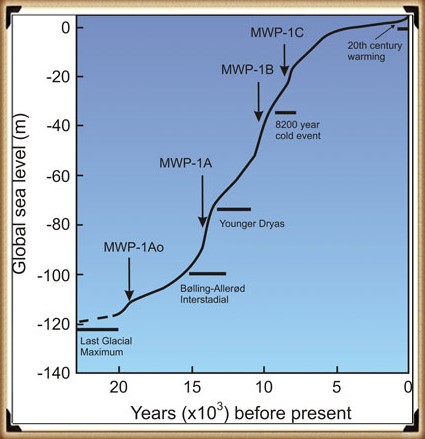
| Figure 58- Historical Sea Level Change – Post Glacial Flooding |
In scrutinising the entirety of sea level variations throughout this protracted interval, one can glean insights into the broader patterns of change and continuity, thereby contributing to the validation or refinement of the model mentioned above, positing groundwater release over 12,500 years as a driving force behind hydrological and geological phenomena.
We have constructed a model of sea-level changes by combining both the Wadden Sea model (Vermeersen et al., 2018) and the NASA sea-level model to calculate the rise in sea level in the North Sea area and the discharge levels from the Rivers that flow into the area over the last 10,000 years since the Last Ice Age (Fig. 59).
Landscape Transformation
A comprehensive analysis of Holocene data, considering elements like substantial meltwater inflows, periodic ice melt pulses, elevated water tables, and heightened precipitation, collectively points to increased hydrological activity and amplified water volumes during this epoch. This convergence of factors underscores the existence and sustainability of significant river systems in the Holocene.
Throughout this epoch, climate fluctuations led to the release of substantial meltwater as ice sheets and glaciers retreated, while periodic ice melt pulses and elevated water tables further contributed to the formation and expansion of rivers. Augmented precipitation levels also bolstered the overall volume of water flowing through these river networks.
These Holocene rivers have served as vital agents of environmental change, influencing ecosystems, facilitating transportation, and shaping the distribution of life forms. The synthesis of this empirical evidence sheds light on the intricate relationship between climate dynamics and the development of extensive river systems during the Holocene, deepening our comprehension of this geological epoch’s hydrological evolution.
Table 1 – Wadden sea level rises and precipitation levels (* Meltwater Pulse).
| BCE | Change (mm) over – 500 years | Discharge Ratio rate – compared to today = 1 | Adjusted Ratio for Discharge – Pulses | Precipitation levels mm pa |
| 950 AD | 50 | 1 | 1 | 450 |
| 450 AD | 400 | 8 | 8 | 430 |
| 50 | 300 | 6 | 6 | 440 |
| 550 | 400 | 8 | 8 | 440 |
| 1050 | 350 | 7 | 7 | 450 |
| 1550 | 350 | 7 | 7 | 375 |
| 2050 | 400 | 8 | 8 | 440 |
| 2550 | 500 | 10 | 10 | 550 |
| 3050 | 1000 | 20 | 20 | 550 |
| 3550 | 1000 | 20 | 20 | 460 |
| 4050 | 1500 | 30 | 30 | 450 |
| 4550 | 1500 | 30 | 30 | 525 |
| 5050 | 1500 | 30 | 30 | 625 |
| 5550 | 6500 | 130 * | 50 | 640 |
| 6050 | 4000 | 80 | 70 | 670 |
| 6550 | 7000 | 140 * | 90 | 630 |
| 7050 | 6000 | 120 | 120 | 600 |
| 7550 | 7000 | 140 | 140 | 400 |
Figure 59, in the context of the provided table, offers an insightful depiction of the Wadden Sea region, situated within the North Sea, and its correlation with rising sea levels concerning river discharge and river size.
The blue line labelled ‘discharge’ on the graph represents the volume of river discharge, consequently reflecting the size and elevation of rivers during the span of the past ten thousand years. In this visualization, the chart adopts the discharge rate observed in 950 AD as the baseline, representing it as one unit. This approach enables a straightforward visual comparison with previous years, presenting the data as a ratio of size.
The graphical representation thus illustrates that as far back as 8050 BCE, the rivers in this region were remarkably more prominent, measuring approximately 140 times the size observed in the contemporary era. This striking contrast in river dimensions over time underscores the profound changes in the Wadden Sea area and highlights the significance of historical river dynamics in shaping the region’s hydrological and geological evolution.
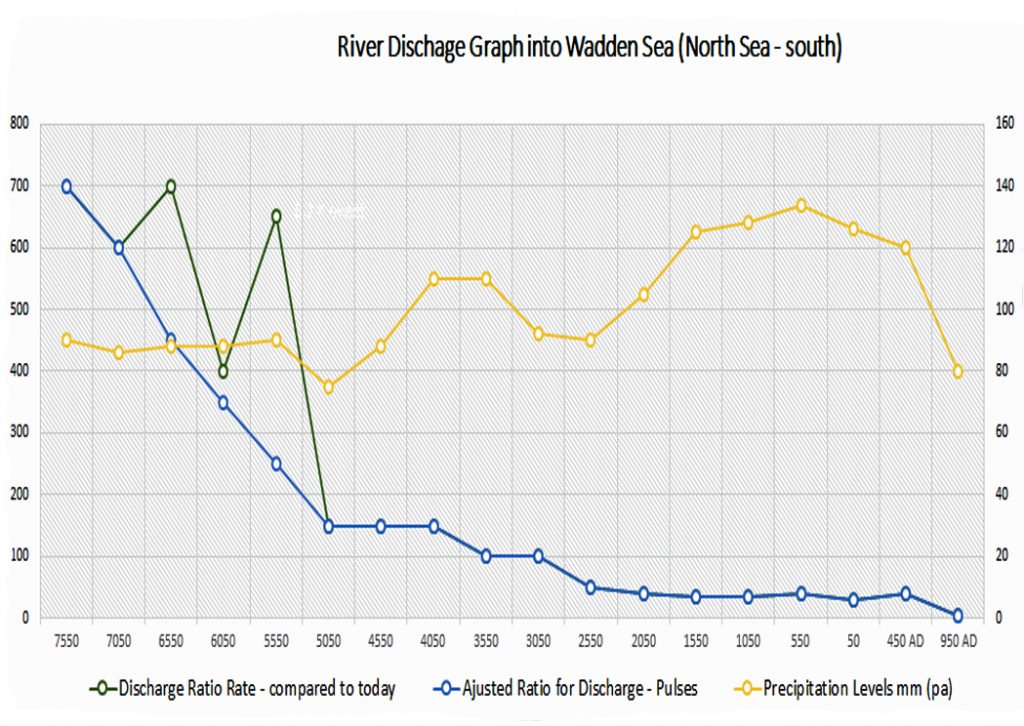
| Figure 59 – Discharges Rates from the Wadden Sea – the yellow graph is precipitation and the green is the water pulses above the estimated steady blue discharge from the water table |
Other Post-Glacial Flooding around the world
Indeed, the post-Last Glacial Maximum (LGM) flooding was not limited to the British Isles alone. The comprehensive examination presented in the trilogy’s first volume, “The Post-Glacial Hypothesis,” has illuminated the widespread nature of these inundations, extending their impact to various regions, including North America.
The empirical data showcased the substantial surge in river discharge following the LGM, with notable examples such as the Mississippi River experiencing an astounding increase from its contemporary rate of 16,790 cubic meters per second (m³/s) to a staggering 160,000 m³/s. This monumental rise, amounting to an 853% increase, distinctly signifies a significant augmentation in river height and discharge.
Similar observations regarding heightened river levels and discharge rates are also discernible in regions like Germany. The cascading consequences of these amplified discharge rates and elevated water levels manifest themselves historically, notably in the context of the Black Sea. Situated approximately 2000 miles from the glacial ice sheet, the Black Sea witnessed the impact of these rising waters, culminating in a historic flooding event.
This inundation event, when the freshwater from the Black Sea overflowed into the Mediterranean, subsequently led to the transformation of the Black Sea from a freshwater body into a saltwater lake. These instances collectively underscore the far-reaching and interconnected implications of post-LGM flooding, which extended well beyond the immediate vicinity of the glacial ice sheets and left a profound imprint on global hydrological and geological dynamics.
Britain’s Post-Glacial Flooding
Lewin and Macklin’s 2003 study is a pivotal contribution to our understanding of Holocene river dynamics. They identified a remarkable 147 channel floods that transpired during the Holocene period, primarily attributable to the rising water table, a phenomenon which persisted up to approximately 1000 years ago. Their work also highlighted the expected trends in sedimentation, theoretically yielding straight-line cumulative plots and uniform probability levels, with deviations indicating episodic or fluctuating trends in sediment activity.
However, the uneven preservation of alluvial units, as noted in Lewin and Macklin’s study, complicates the interpretation of the Holocene sedimentary record. This variance in preservation primarily affects later Holocene sediments and can result in the spikiness observed in the illustrated plots. Additionally, radiocarbon dating materials can exhibit clustering due to 14C production variability, which may or may not align with flood events. Thus, the complexity of the data presented underscores the need for a nuanced interpretation of episodic alluviation.
Subsequently, the study investigated the Thames River as a case study to elucidate how Britain’s most prominent river was impacted during the Mesolithic and Neolithic periods. A discharge model was constructed based on sedimentary data from the British Geological Society’s superficial maps and borehole core samples. The findings of this study revealed a striking increase in the current average discharge of the Thames River, indicating a 3723% augmentation within the watershed area. This, in turn, allowed for an estimation that at its peak, the Thames River discharged approximately 2450 m³/s (0.0025 gigatonnes per second or 1314 gigatonnes per annum), a rate akin to some smaller rivers in North America during the same period.
This raises a pertinent question about the Thames River’s historical behaviour and potential relationship with the meltwater from the last ice age. To delve deeper into this inquiry, a meticulous excavation at the edge of the BGS superficial Alluvium flood map was undertaken to provide tangible evidence regarding the nature of the sediments observed in the geological record. The cross-section profile of the Thames revealed an expansion of the Holocene superficial sediment area by at least one mile, terminating at Boreholes TQ47NE344 and TQ58NW141. These boreholes demonstrated significant sediment thickness before reaching underlying geological strata.
The implications of these findings are profound, as they substantially augment the Thames Flood Model, projecting a discharge of 12,250 m³/s. This revised estimate aligns more closely with the North American Discharge Model, prompting a reevaluation of the Thames River’s historical behaviour and the influence of post-glacial meltwater dynamics on its hydrological profile.
Peat (Ultimate Evidence of Holocene Flooding).
The formation of bogs in the UK commenced around 10,000 years ago, coinciding with the conclusion of the last ice age when glaciers withdrew northwards, leaving behind a terrain characterized by shallow meltwater lakes and waterlogged depressions. A substantial portion of the UK’s land area, approximately 2.3 million hectares or 9.5%, is now covered by bog peatlands.
Peat, commonly known as turf, constitutes an accumulation of partially decomposed organic matter, with Sphagnum moss being one of the predominant contributors. Soils primarily composed of peat are referred to as histosols. Peat formation occurs in wetland environments where oxygen supply from the atmosphere is impeded due to flooding, resulting in reduced decomposition rates.
While bogs represent a prominent source of peat, other less common wetland types, including fens, pocosins, and peat swamp forests, also contribute to peat deposition. Various terms describe lands dominated by peat, such as moors, muskeg, or mires. These landscapes support specific plant species, notably Sphagnum moss, Ericaceous shrubs, and sedges. Since organic matter accumulates over millennia, peat deposits offer valuable records of past vegetation and climates preserved in plant remains, particularly pollen. Consequently, they facilitate the reconstruction of historical environments and changes in land use.
Peat develops where plant material, typically in marshy areas, undergoes incomplete decay due to acidic and anaerobic (oxygen-deprived) conditions. It primarily consists of organic remains from marshland vegetation, including trees, grasses, fungi, insects, and animal remains. Under specific requirements, the decomposition of these materials is constrained, making peat layers valuable for archaeological investigations.
The growth of peat layers and the extent of decomposition depend primarily on factors such as composition and waterlogging. Peat formed in very wet conditions accumulates more rapidly and experiences less decomposition than in drier environments, making it a valuable indicator of climatic change for climatologists.
Unlike subsoils like head and alluvium, peat bogs can often be precisely carbon-dated, a crucial aspect of understanding post-glacial flooding. The flooded regions of Britain are prime candidates for the development of marshes and swamps, contributing to the formation of contemporary peat subsoils.
Peat not only aids in identifying Holocene wet areas and elevated river levels but also assists in determining the size and flow of rivers during the Mesolithic and Neolithic periods. Blanket bog, which occupies approximately 6% of the UK’s current land area, has historically been attributed to Neolithic forest clearance. However, recent predictive models, such as PeatStash, based on summer temperature and moisture index thresholds, provide accurate predictions of the present distribution of blanket bog in Great Britain. Additionally, these models explain the global distribution of blanket bog ecosystems.
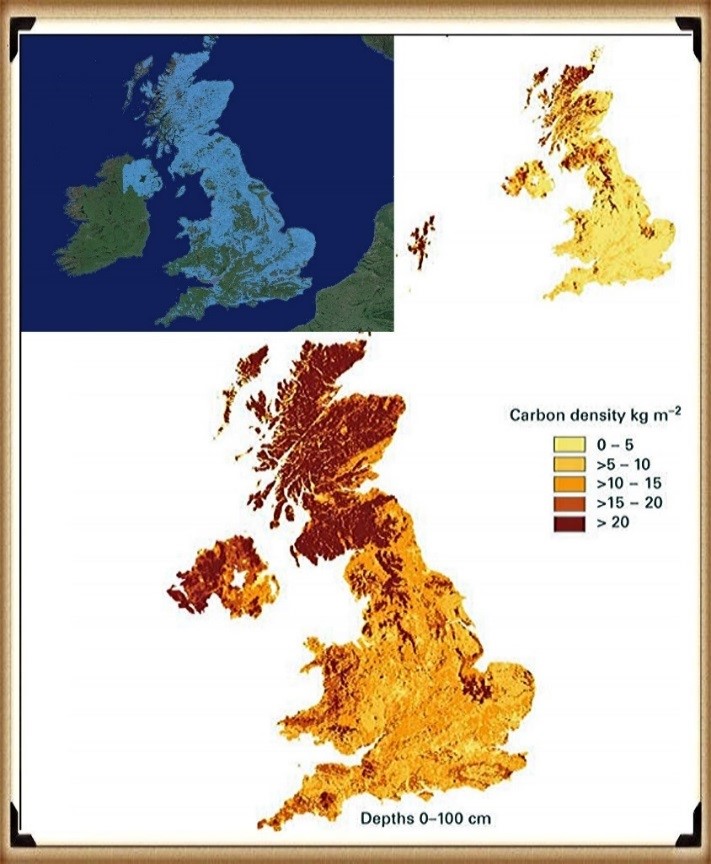
| Figure 60- Peat growth – reflecting the post-glacial flooding of Britain (blue map) |
The discovery made by Gallego-Sala and colleagues in 2016 suggests that climate factors predominantly control the distribution of blanket bogs in the UK and globally rather than being primarily influenced by historical land-use practices.
Interestingly, the maximum rate of peat production doesn’t align with the immediate post-meltwater flooding period following the Last Glacial Maximum. If one were to anticipate a direct correlation, the peak peat growth would logically occur in the early Holocene period, shortly after the rapid recession of floodwaters. However, as exemplified in Scotland (Figure 61), empirical observations reveal a 4000 to 6000-year lag between the post-glacial period and the peak peat growth.
This delay can be attributed to the hydrological dynamics of the early Holocene, characterized by the highest and most rapid river flows. During this phase, the environmental conditions were unfavourable for the establishment and growth of marshes and bogs. It is only as the rivers gradually receded that suitable conditions for peat formation began to emerge. This process of peat formation was occasionally disrupted by flooding events triggered by precipitation towards the end of the Neolithic period, coinciding with the advent of farming practices.
In essence, this temporal discrepancy underscores the intricate relationship between river behaviour, climate, and the development of peatlands during the Holocene. It challenges the assumption that post-glacial flooding directly leads to peat growth and emphasizes the role of evolving hydrological conditions in shaping the timing and extent of peatland formation.
For more information about British Prehistory and other articles/books, go to our BLOG WEBSITE for daily updates or our VIDEO CHANNEL for interactive media and documentaries. The TRILOGY of books that ‘changed history’ can be found with chapter extracts at DAWN OF THE LOST CIVILISATION, THE STONEHENGE ENIGMA and THE POST-GLACIAL FLOODING HYPOTHESIS. Other associated books are also available such as 13 THINGS THAT DON’T MAKE SENSE IN HISTORY and other ‘short’ budget priced books can be found on our AUTHOR SITE. For active discussion on the findings of the TRILOGY and recent LiDAR investigations that is published on our WEBSITE you can join our FACEBOOK GROUP.

